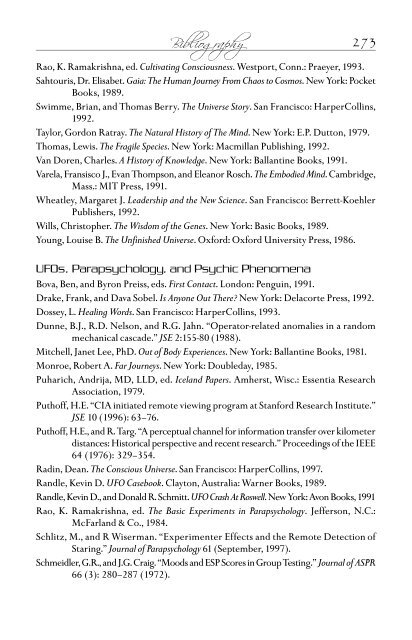edgar-mitchell
edgar-mitchell
edgar-mitchell
Create successful ePaper yourself
Turn your PDF publications into a flip-book with our unique Google optimized e-Paper software.
Invisible Realities 137<br />
nuances of words, construed literally or metaphorically, can shift the truth<br />
of knowing.<br />
Whenever trees have fallen in the past, they likely behaved just as they<br />
had before humans made an issue of it by asking annoying questions. Likewise,<br />
the universal processes proceeded to unfold as they did before<br />
quantum mechanics, Newtonian mathematics, and telescopes—long before<br />
humans began to second-guess the processes and create these “maps.”<br />
The territory they represent seems to have existed long before our maps<br />
and the anthropoid mentality that created them.<br />
The anthropic consciousness and mentality we experience today certainly<br />
seems important to the future evolution of the universe. We have<br />
radically altered the face of the planet, particularly in recent years, not<br />
only by our very existence, but also because of intentional choices. If consciousness<br />
is important to the universe, what then is its exact nature, and<br />
how did it manifest before we humans evolved to the state of awakened<br />
awareness we currently enjoy An investigation of quantum mechanics with<br />
consciousness in the picture begins to yield some interesting and useful<br />
answers.<br />
The now-classic wave/particle demonstration, called the double-slit<br />
experiment, has undergone exotic refinements through the years to help us<br />
better understand this strange phenomenon, and to shed light on the several<br />
paradoxes of quantum theory. An example of the experiment consists<br />
of a source of light, a photosensitive screen to capture the light, and a<br />
device that can split the light beam into two beams at the will of the experimenter<br />
before it reaches the recording device.<br />
In principle this is a simple experiment. If only one beam of light is<br />
used, all the photons cluster in a blob around the center of the recording<br />
screen, just like a flashlight beam projected on a wall. If the beam is split<br />
into two beams by a beam splitter and then refocused, an interference<br />
pattern showing alternate light and dark areas will appear on the screen.<br />
All wave equations predict this result, but particle equations predict two<br />
independent blobs of light—not an interference pattern. This was the original<br />
proof of wave/particle duality.<br />
All refinements of the double-slit experiment have been made with<br />
one or both of two primary goals in mind: The first goal has been to catch<br />
the wave/particle behaving as a Newtonian particle between measurements,<br />
thereby showing that classical ideas and pictures of reality prevail.<br />
This, of course, would deny the distasteful uncertainty principle, making<br />
the proponents of classical physics very happy. The second goal has been to<br />
discover how, what, or when the wave/particles know. But even though<br />
the wave/particles have remained enigmatic, a few telling facts have been<br />
gleaned.


